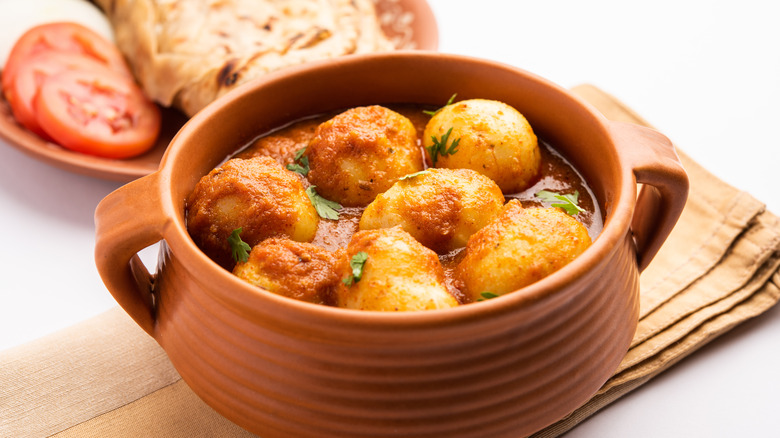Indian Onion Paste Works As A Delicious Foundation For Countless Meals
Tandoori chicken, biryani, samosa, and other Indian dishes contain a variety of spices, herbs, and base ingredients that give them their unique flavors. We use many of these ingredients in Western cuisine, too, but we tend to prep and mix them differently. A good example is brown onion paste, an Indian recipe that is a foundation for many gravies, curries, and traditional meals like Kashmiri gushtaba. It imparts a rich flavor to these dishes, but usually just consists of fried caramelized onions, yogurt, and oil, although some recipes may also call for cashew or melon seed paste and other ingredients.
Chef Debu Saha, the owner of a bistro in Toronto, Canada, says that many Indian cooks use five or six gravies as the base for their dishes. These are often referred to as "mother sauces," and one of them is brown onion paste. "I've been making this brown onion paste gravy since I started cooking professionally," Saha told Toronto.com. He added, " You can turn it into a curry to go with meat and vegetables or use it as a marinade for meat."
However, Indian onion paste can serve as a foundation for countless other meals. Its mild but full flavor pairs well with meat, potatoes, grains, vegetables, and more. You can even use it as a dip or topping for your go-to snacks and appetizers.
What is brown onion paste?
Brown onion paste is a staple of Mughlai cuisine, a style of cooking that emerged between 1526 and 1858. During this period, India was ruled by the Mughal dynasty. Kofta, kebabs, chicken biryani, and other Mughlai dishes are still found in most Indian restaurants, being prized for their distinct flavors. Some recipes call for gravies or other sauces made with boiled or fried onion paste. The latter has a beautiful brown color, a thick consistency, and a slightly sweet aroma.
This paste requires just two or three ingredients, such as red onions and oil or ghee. But, as mentioned earlier, some chefs also add yogurt, blended cashews, salt, and spices like garlic or ginger. The onions are deep-fried in oil until they turn brown, allowing their natural sugars to caramelize. Once fully cooked, they're left to cool and then blended with their oil in a food processor.
The resulting paste is both sweet and savory, with a velvety texture. Green chili peppers, ginger, and other spices can further enhance its flavor. Note that some recipes call for raw or boiled onion paste, which is different from brown onion paste. The latter is fried and has a distinctive brown color and caramelized flavor.
Creative ways to use fried onion paste in your recipes
Indian onion paste, whether fried or boiled, can be a wonderful addition to chicken curries, paneer makhani, vegetable kurma, dum aloo, and other traditional dishes. For example, chicken kofta curry is often made with brown onion paste, garlic, cilantro, cumin, and other spices. Kashmiri gushtaba, a traditional wedding dish, calls for fried onion paste, mutton fat, yogurt, and various spices, such as black and green cardamoms, fennel seed powder, and cloves.
Feeling creative? Use fried onion paste to make your everyday meals more flavorful. Spread it on sandwiches, stir it into pasta sauces, or eat it with toast for a quick snack. Its texture is similar to that of Thai curry paste, so you can mix it into your favorite dips. For instance, combine brown onion paste with Greek yogurt along with some herbs and spices to make a dip for chips or veggie sticks.
Another option is to incorporate the paste into meatballs, hummus, or homemade spreads. You can also use it to make flavored butters for crostinis, vegetables, steaks, or toast. If you plan to make focaccia, mix fried onion paste into the dough before baking for extra flavor. Once it's cooked, top it with bacon, dried tomatoes, cheese, olives, or garlic butter to turn it into a restaurant-worthy appetizer.


